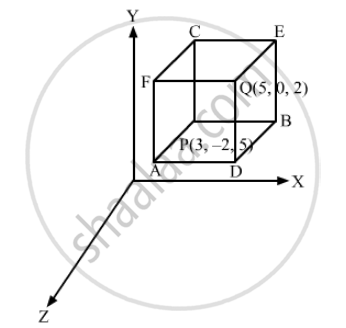Advertisements
Advertisements
प्रश्न
Planes are drawn through the points (5, 0, 2) and (3, –2, 5) parallel to the coordinate planes. Find the lengths of the edges of the rectangular parallelepiped so formed.
उत्तर

Clearly, PBEC and QDAF are the planes parallel to the yz-plane such that their distances from the yz-plane are 5 and 3, respectively.
\[\therefore\]PA = Distance between planes PBEC and QDAF
= 5\[-\]3
= 2
PB is the distance between planes PAFC and BDQE that are parallel to the zx-plane and are at distances 0 and\[-\]2,respectively, from the zx-plane.
\[\therefore\]PB = 0
\[-\](\[-\]2)
= 2
PC is the distance between parallel planes PBDA and CEQF that are at distances 2 and 5, respectively, from the xy-plane.
\[\therefore\]PC = 2\[-\]5
=\[-\]3
APPEARS IN
संबंधित प्रश्न
Name the octants in which the following points lie:
(1, 2, 3), (4, –2, 3), (4, –2, –5), (4, 2, –5), (–4, 2, –5), (–4, 2, 5),
(–3, –1, 6), (2, –4, –7).
Coordinate planes divide the space into ______ octants.
Name the octants in which the following points lie:
(–5, –3, –2)
Name the octants in which the following points lie:
(2, –5, –7)
Find the image of:
(–2, 3, 4) in the yz-plane.
Find the image of:
(–5, 4, –3) in the xz-plane.
Find the image of:
(5, 2, –7) in the xy-plane.
Find the image of:
(–4, 0, 0) in the xy-plane.
A cube of side 5 has one vertex at the point (1, 0, –1), and the three edges from this vertex are, respectively, parallel to the negative x and y axes and positive z-axis. Find the coordinates of the other vertices of the cube.
Determine the points in zx-plane are equidistant from the points A(1, –1, 0), B(2, 1, 2) and C(3, 2, –1).
Determine the point on z-axis which is equidistant from the points (1, 5, 7) and (5, 1, –4).
Find the points on z-axis which are at a distance \[\sqrt{21}\]from the point (1, 2, 3).
Are the points A(3, 6, 9), B(10, 20, 30) and C(25, –41, 5), the vertices of a right-angled triangle?
Verify the following:
(0, 7, –10), (1, 6, –6) and (4, 9, –6) are vertices of an isosceles triangle.
Verify the following:
(0, 7, –10), (1, 6, –6) and (4, 9, –6) are vertices of an isosceles triangle.
XOZ-plane divides the join of (2, 3, 1) and (6, 7, 1) in the ratio
The coordinates of the foot of the perpendicular drawn from the point P(3, 4, 5) on the yz- plane are
The coordinates of the foot of the perpendicular from a point P(6,7, 8) on x - axis are
The perpendicular distance of the point P (6, 7, 8) from xy - plane is
The perpendicular distance of the point P(3, 3,4) from the x-axis is
The length of the perpendicular drawn from the point P(a, b, c) from z-axis is
If the direction ratios of a line are 1, 1, 2, find the direction cosines of the line.
The x-coordinate of a point on the line joining the points Q(2, 2, 1) and R(5, 1, –2) is 4. Find its z-coordinate.
If a line makes angles α, β, γ with the positive directions of the coordinate axes, then the value of sin2α + sin2β + sin2γ is ______.
If a line makes an angle of `pi/4` with each of y and z axis, then the angle which it makes with x-axis is ______.
Find the angle between the lines whose direction cosines are given by the equations l + m + n = 0, l2 + m2 – n2 = 0
If a variable line in two adjacent positions has direction cosines l, m, n and l + δl, m + δm, n + δn, show that the small angle δθ between the two positions is given by δθ2 = δl2 + δm2 + δn2
O is the origin and A is (a, b, c). Find the direction cosines of the line OA and the equation of plane through A at right angle to OA.
Find the foot of perpendicular from the point (2,3,–8) to the line `(4 - x)/2 = y/6 = (1 - z)/3`. Also, find the perpendicular distance from the given point to the line.
The plane ax + by = 0 is rotated about its line of intersection with the plane z = 0 through an angle α. Prove that the equation of the plane in its new position is ax + by `+- (sqrt(a^2 + b^2) tan alpha)z ` = 0
If l1, m1, n1 ; l2, m2, n2 ; l3, m3, n3 are the direction cosines of three mutually perpendicular lines, prove that the line whose direction cosines are proportional to l1 + l2 + l3, m1 + m2 + m3, n1 + n2 + n3 makes equal angles with them.
If the directions cosines of a line are k, k, k, then ______.
The vector equation of the line through the points (3, 4, –7) and (1, –1, 6) is ______.
The cartesian equation of the plane `vecr * (hati + hatj - hatk)` is ______.
The angle between the planes `vecr.(2hati - 3hatj + hatk)` = 1 and `vecr.(hati - hatj)` = 4 is `cos^-1((-5)/sqrt(58))`.
The vector equation of the line `(x - 5)/3 = (y + 4)/7 = (z - 6)/2` is `vecr = (5hati - 4hatj + 6hatk) + lambda(3hati + 7hatj - 2hatk)`.
